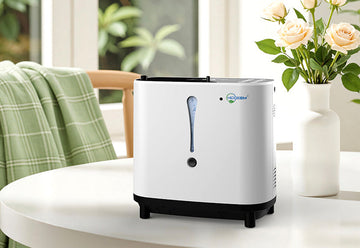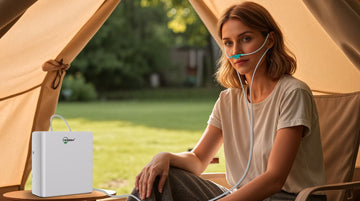What is Continuous Flow Oxygen Concentrator? What is Pulse Flow Oxygen Concentrator?
by AdminHIDGEEM on Jul 24, 2025

The Working Principle of Oxygen Concentrator
An oxygen concentrator is a device that can provide high-concentration oxygen to people who need oxygen.
The oxygen concentration in the air is about 21%, and the nitrogen concentration is the highest one, about 78%.
The diameter of an oxygen molecule is very small, it is about 0.346nm, while the diameter of a nitrogen molecule is much bigger, it is about 0.380nm.
Therefore, in the oxygen concentrator, the motor pushes the air into the molecular sieve, which molecular diameters is very small, and use the molecular sieve to filter out nitrogen molecules, only allowing oxygen molecules to pass through, and then store the oxygen in a gas tank for patients to breathe. This is the working principle of the oxygen concentrator.
What Are Continuous Flow and Pulse Flow Oxygen Concentrators?
There are two types of oxygen concentrators: continuous flow and pulse flow (also called demand flow).
Continuous flow concentrators produce oxygen continuously at a fixed rate, independent of the user's breathing pattern.
Pulse flow concentrators, however, operate differently. They only deliver oxygen when the user inhales and pause during exhalation. While paused, the machine continues producing oxygen, storing it for the next inhalation.
For example:
• A 1L continuous flow concentrator delivers a constant 1 liter of oxygen per minute.
• A pulse flow concentrator set to 1L works differently. Suppose an adult's breathing cycle consists of 1 second inhaling and 2 seconds exhaling. The device delivers oxygen only during the 1-second inhalation and stores oxygen during the 2-second exhalation period.
Thus, while both devices may produce 1 liter of oxygen per minute, the pulse flow concentrator accumulates stored oxygen during exhalation. This allows it to deliver a higher concentrated bolus per breath compared to the steady flow of a continuous device.

What are the Advantages and Disadvantages of Continuous Flow Oxygen Concentrators or Pulse Flow Oxygen Concentrators?
The continuous flow oxygen concentrators are suitable for people with high demand of oxygen (e.g., during sleep or intense activity).
The continuous flow oxygen concentrators can deliver oxygen constantly, so they are ideal for users with weak or irregular breathing patterns.
The pulse flow oxygen concentrators usually are smaller and lighter than continuous flow oxygen concentrators. They are suitable for people with stable breathing patterns and moderate oxygen needs. They are not suitable for the people with very weak/shallow breaths because the sensors of breathe can miss triggering.
The price of pulse flow oxygen concentrator usually is cheaper, but the oxygen concentration is lower than continuous flow oxygen concentrator.
Please choose the suitable oxygen concentrator that can meet your requirements.
Hidgeem SJ-OX1C Oxygen Concentrator and SJ-OX1A Oxygen Concentrator

Hidgeem SJ-OX1C is portable oxygen concentrator with battery. Here are some features of SJ-OX1C oxygen concentrator:
1. It is continuous flow oxygen concentrator. The oxygen concentration of 1L is up to 93%+/-3%, very stable.
2. With 5400mAh battery, suitable for home & outdoors & car use.
3. Nebulizer function available
4. Ship with a multifunctional portable carrying bag
5. The battery supports at least 100 minutes working time
6. Support 3 kinds of power supply: AC adapter, car charger and battery.
7. Not only the battery is rechargeable, and the molecular sieve is also replaceable, extended the life time of the oxygen machine.
Hidgeem SJ-OX1A is oxygen concentrator for home use. You can use it at home by AC adapter:
1. Very nice design. It is not only an oxygen concentrator, but also a beautiful home decoration device.
2. It is continuous flow oxygen concentrator, The oxygen concentration of 1L is up to 93%+/-3%.
3. Very low noise (<45dB), very suitable to use when sleep.
4. Can use in the car with car charger
5. Multi-functions such as timing on and off, oxygen flow adjustable, SOS function, etc.



